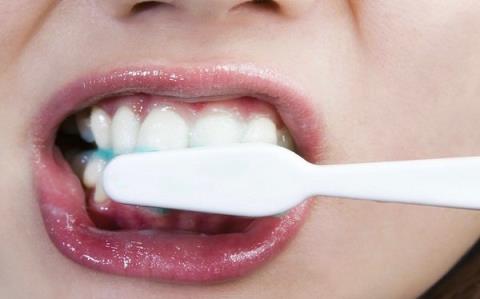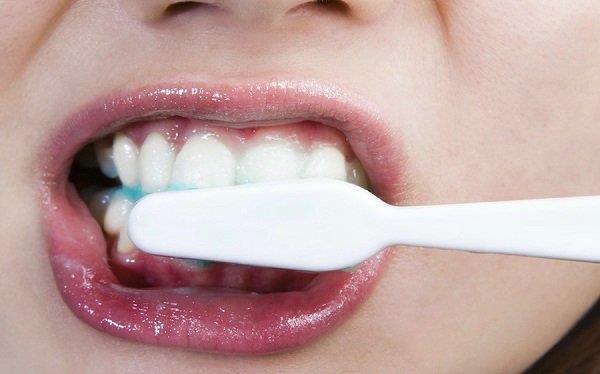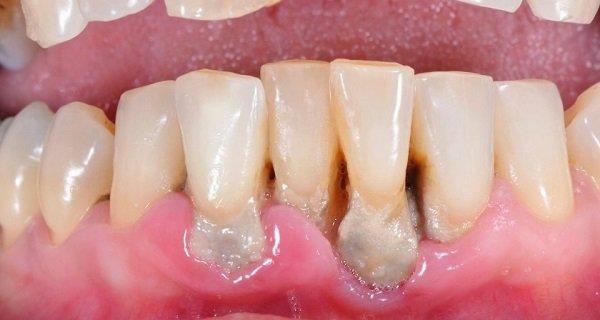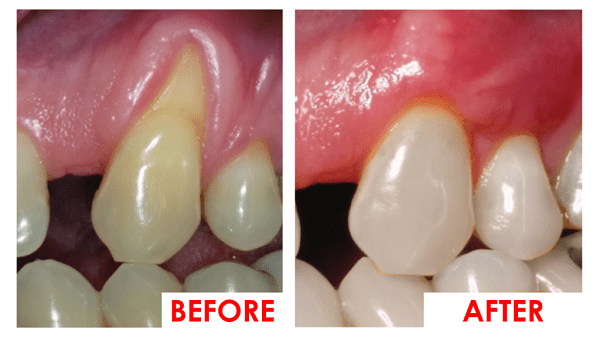Receding gums: Causes, prevention and treatment

Receding gums is a common dental problem. Most people don't know they have receding gums because it happens gradually. The first sign of receding gums is often tooth sensitivity, or you may notice that your teeth look longer than usual. Receding gums is a condition that requires treatment. If you think your gums are receding, see your dentist right away. There are treatments that can help restore gums and prevent further damage. The following article will provide you with all the necessary information about this situation.
content
- 1. Cause
- 2. Symptoms of receding gums
- 3. Complications of receding gums
- 4. How to treat receding gums?
- 5. Prevent receding gums
1. Cause
There are several factors that can cause your gums to recede including:
-
Periodontal diseases .
When plaque builds up on teeth, it can cause gingivitis and can lead to periodontitis. Periodontitis creates space between the gums and teeth, plus the loss of connective fibers and bone around the roots of the teeth. This can lead to receding gums and bone loss.
Periodontal disease is a common cause of receding gums. Periodontal disease causes loss of supporting bone and tissue around the tooth due to an inflammatory response. Receding gums tends to affect all teeth.
-
Inadequate dental care.
Improper brushing, not flossing and rinsing with antibacterial mouthwash can cause plaque to turn into tartar (tartar). It's a hard substance that sticks to and between teeth and can only be removed with a professional dental cleaning. It can lead to receding gums. However, receding gums can also occur in people with good oral hygiene.
-
Brushing teeth too hard, wrong way.
Physical abrasion of the gums and inflammation of the tissues are the main reasons for receding gums. Abrasion of the gums from vigorous brushing or the use of a stiff brush is an even more common cause of receding gums. Brushing too hard causes receding gums even when oral hygiene can be good.
Receding gums usually affect the left side of the mouth more often. This is because most people use the toothbrush with their right hand and put more pressure on the gum on the left. It also tends to affect the gums of the posterior teeth more than the anterior teeth.

Brushing too hard is also one of the causes of receding gums.
-
Genetic factors.
Some people may also be prone to receding gums due to genetic factors. These factors include: the position of the teeth and the thickness of the gums. Some people may be more susceptible to gum disease. In fact, studies show that 30% of the population may be susceptible to gum disease, regardless of how well they take care of their teeth. Some people are more susceptible to inflammatory causes of receding gums because they have more tissue. thinner. Thinner gum tissue is more prone to infection than plaque.
- Other physical factors include : lip or tongue piercing and damage from dental treatment.
-
Age
Age is a major risk factor. About 88% of people over the age of 65 have receding gums in at least one tooth.
- Diabetes can also increase the risk of receding gums.
-
Hormonal changes.
Changes in female hormone levels throughout a woman's life, such as during puberty, pregnancy, and menopause, can make gums more sensitive and more prone to receding gums.
-
Use tobacco.
Tobacco users easily have plaque on their teeth, which is difficult to remove and can cause receding gums.
-
Chatter
Grinding or clenching can put too much force on the teeth, causing the gums to recede.
-
Crooked teeth or misaligned bite.
When teeth grow unevenly, it can put too much force on the gums and bone, causing the gums to recede.
2. Symptoms of receding gums
Receding gums can make teeth sensitive to heat and cold. Many people with receding gums may not notice them early on and may not know that their gums are receding. However, the following may occur:
- Sensitivity to cold and heat due to the root's exposure to the environment.
- The crown becomes longer.
- The gum area between the teeth disappears, making the space between the teeth look wider.
- May be accompanied by loose teeth, pain.
- Most importantly, receding gums can be a symptom of underlying dental problems; including gum disease and may increase the risk of tooth decay and tooth loss.
- They can also lead to bad breath and bleeding gums.
See more articles: Teeth whitening methods at home: Do's and Don'ts!
3. Complications of receding gums
The CDA estimates that periodontal diseases such as receding gums are responsible for about 70% of adult tooth loss cases. When there isn't enough gum tissue to hold the roots in place, teeth are more likely to fall out. In some cases, many loose teeth are removed by the dentist before they fall out. Receding gums also affects the aesthetics of the patient. When the gums recede, the teeth look longer, the gap between the teeth seems wider and more sparse.
4. How to treat receding gums?
4.1. Mild condition
-
Can be treated by a dentist with a deep cleaning of the affected area.
During deep cleaning – scaling or root surface treatment; Plaque and tartar accumulated on the teeth and root surfaces below the gum line are carefully removed. The exposed root area is smoothed to make it harder for bacteria to get in.

Periodontitis causes receding gums.
- Your doctor may prescribe more antibiotics to get rid of any harmful bacteria left behind . Options include: topical antibiotic gel; antiseptic chips; antibacterial mouthwash; enzyme inhibitors.
-
Desensitizers, varnishes and dentin binders.
These products are intended to reduce the sensitivity of exposed roots. Desensitizers treat neurological symptoms and help maintain oral hygiene by reducing sensitive brushing.
-
Composite restoration.
Dentists use tooth-colored composite resin to cover the surface of the tooth root. They can also close the black spaces between teeth, but to a lesser extent.
-
Porcelain or composite pink.
This material has a pink color similar to the color of the gums and can be applied to fill in the gaps where the gums recede.
-
The gum patches are removable.
These are usually acrylic or silicone, and they artificially replace much of the gum tissue lost due to receding gums.
-
Orthodontic.
Includes treatments that slowly move the position of the teeth over a long period of time. This repositioning can realign the gum line and make it easier to keep teeth clean.
4.2. Severe condition
If your receding gums cannot be treated with a deep cleaning because of the excessive bone loss and the pockets are too deep. You may need gum surgery to repair damage caused by receding gums.
Types of surgery used to treat this condition include:
-
Flip flap surgery, treatment of tooth roots.
Flap surgery is a method of deep tissue cleaning; Used if other treatments are unsuccessful. It helps to remove bacteria and tartar that accumulate in the gums. Sometimes teeth can last longer after flap surgery because the gums are closer around them.
During this procedure, the dentist or periodontist flips the affected gum tissue, removing harmful bacteria from the pocket. Then reposition the gum tissue into position on the root. Thus eliminating bags or reducing their size.
-
Reconstructive surgery.
If the bone supporting your teeth has been destroyed by receding gums, a procedure to rebuild the lost bone and tissue may be recommended. As with reducing the depth of the pocket, the dentist will flip the gum tissue and remove the bacteria. A regenerative material, such as a membrane, graft, or tissue-stimulating protein. It is then placed in the area of bone loss to promote your body's natural regeneration of bone and tissue in that area. After the reconstructive material is in place, gum tissue is placed back to protect the material on the root. It is important to note that this process cannot be successful in the long run without proper oral health care.
-
Soft tissue graft.
There are several types of gum tissue grafting procedures, but the most commonly used type is called a connective tissue transplant. In this procedure, a flap of skin is cut in the roof of the mouth and tissue from under that flap, called subepithelial connective tissue, is removed. It is then sutured with the gum tissue surrounding the root exposed. After the connective tissue has been removed from the flap, the graft is sutured. In another type of graft, called a free gum graft, tissue is taken directly from the roof of the mouth. Sometimes, if you have enough gum tissue around the affected teeth, the dentist can graft the gums from the areas near the teeth and not remove the tissue from the roof of the mouth.
Now, thanks to the development of biomaterials and advanced engineering, there are a number of synthetic materials that support graft replacement. However, their cost is relatively high.

Photos before and after treatment for receding gums in severe condition.
5. Prevent receding gums
Ways to prevent it include:
- The best way to prevent receding gums is to take good care of your teeth.
Brush and floss your teeth every day and see your dentist or dentist at least twice a year, or as recommended. If you have receding gums, your dentist may ask you to see them more often. Always use a soft-bristled toothbrush and ask your dentist to show you the proper brushing technique. You can refer to the following article: Dental floss and water flosser: Which tool is better?
- If a misaligned bite or teeth grinding is to blame, talk to your dentist about how to correct the problem.
- Quit smoking.
- Balanced and healthy diet.
- Watch for possible changes in your mouth.
- Perhaps one of the best ways to prevent receding gums is to visit your dentist regularly for regular cleanings and checkups. Even if you don't experience any symptoms, your dentist can identify early signs of gum disease.
The outlook for recovery in the early stages of gum disease can be good, but only if the problem is treated early. You also don't have to wait for your dentist to detect signs of receding gums. If something in your mouth doesn't look like it or isn't right, call your dentist right away. You can treat gingivitis before it progresses to receding gums.
Doctor Truong My Linh